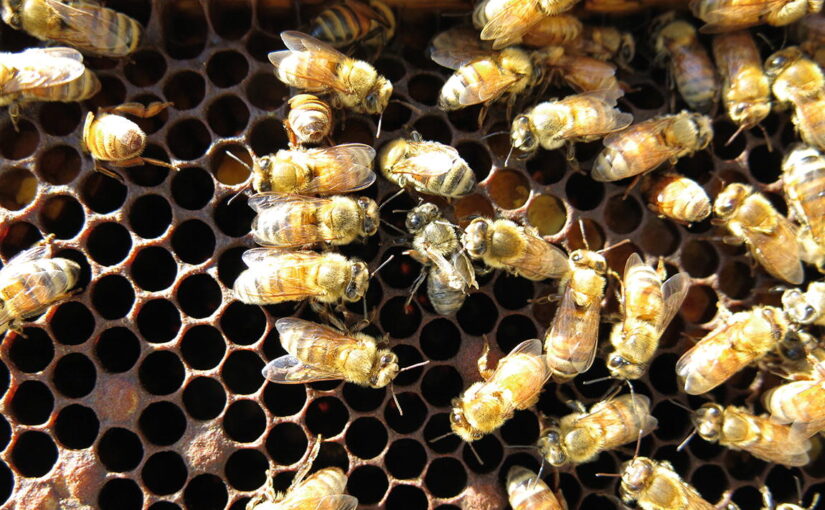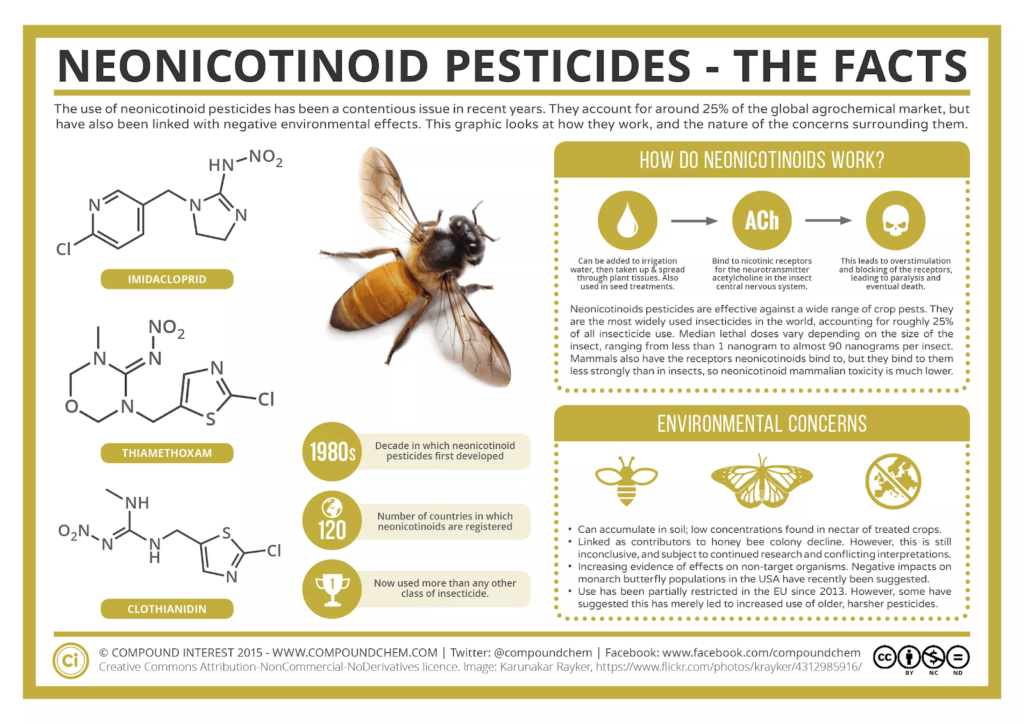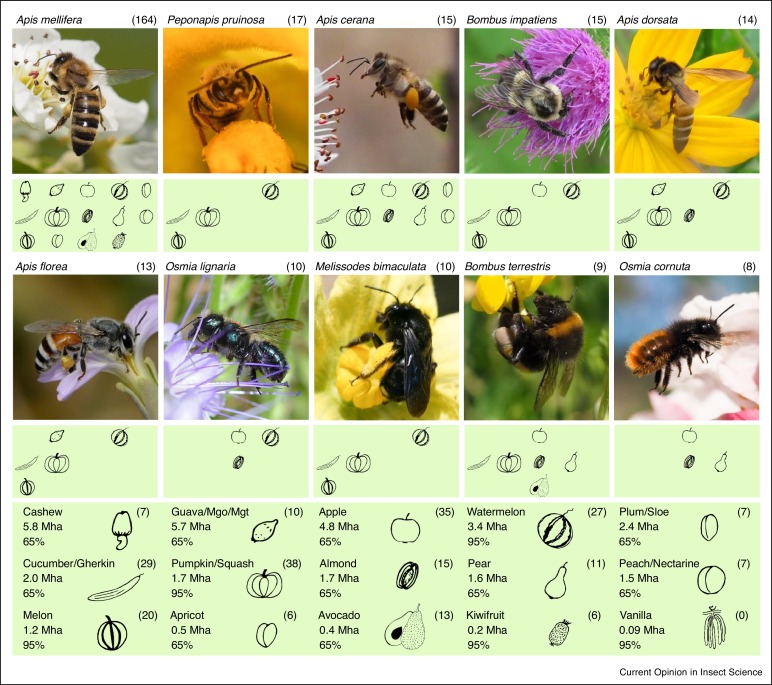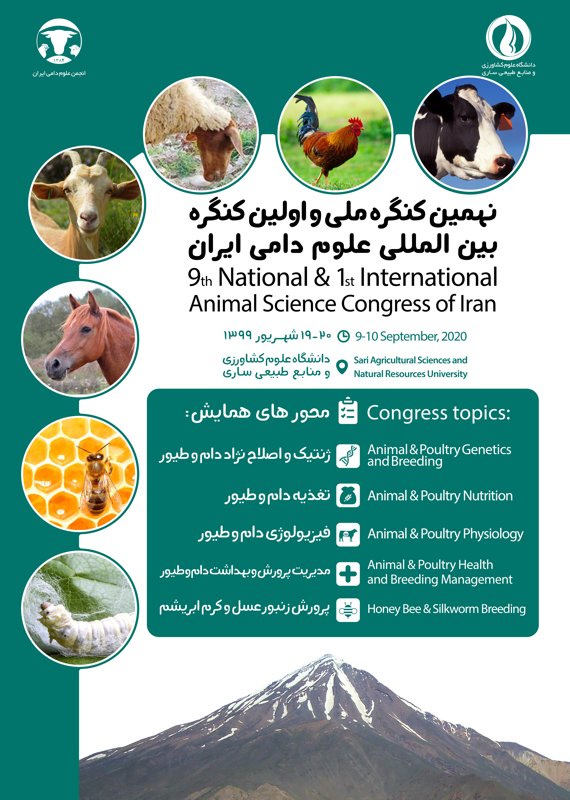Managing bees life by humans
Throughout history, humans have managed bees for their products. People used bees as a weapon [1] and as a model for organization, ethics and healing [2]. These methods show the long-term human interaction and perhaps the constant fascination of bees. The importance of bees for food pollination has been proven. These foods are essential for human survival. Bees also play an important role in pollinating many trees and flowers that provide wildlife habitats, so keeping the planet is highly dependent on bees [3]. Much of the planet’s pollination on the planet depends on bees. But unfortunately, many factors have put these useful pollutants at risk. The most important issue that has been considered in recent research is the risk factors due to improper human activity. Human by changing the lands for agricultural, construction, etc. purposes, have changed the habitat of these useful pollinators. The use of intensive farming methods and individual transportation also causes fundamental changes in the habitat of bees. Single crop cultivation on agricultural land is another factor affecting bee populations. However, the use of pesticides has the greatest impact on the colony population of managed bees, and on a large scale will cause fragmentation and destruction of the habitat of these pollinators [4]. Pests and diseases are also a threat to bee colonies, some of which have occurred as a result of long-distance transportation among bees. In addition, higher temperatures, changing seasons and severe weather events are also a problem for bees [5]. Pollinator insects and bees -which are the main focus of this study- are affected by a wide range of human activities [4], from the use of pesticides (such as insecticides, fungicides, etc.)- is the most important and effective human activity on the bee population- to agricultural activities (including land reform and land use change at various levels), destroys the semi-natural habitats of these insects [6]. Such disruption often leads to reduced pollination and / or reduced diversity of plant species, which in turn reduces crop yields in adjacent agricultural areas [5]. The main reason for the spread of diseases in Honey bees (Apis mellifera) is the destructive human activities mentioned above. The Apis mellifera is the most well-known species in the world that pollinates and produces honey [7]. Today, bees face complex problems. The main problems mentioned are only due to misconduct and improper human performance, and by changing human activities, these problems can be prevented [8]. One of the most important disorders that is considered to be the main cause of human activities is Colony Collapse Disorder (CCD) that as a result of this disorder, colony face the adult’s tragedy of leaving the hive, and the larvae are released alone and die [9]. Researches has shown that the main causes of CCD are due to human activities such as climate change and global warming, the spread of parasites caused by human activities, the occurrence of diseases among colony that can also be caused by human activities, being exposed to chemical toxins and pesticides that humans use for the purpose of combating harmful pests, as well as to destroy the natural and semi-natural habitat of these pollinators, which is caused by various human activities [10]. Also, the development and changes of land use for construction purposes, agricultural and livestock products, electromagnetic pollution caused by radiation from mobile waves, telecommunication and radio waves, and most importantly the use of chemical pesticides and pesticides such as neonotinoids; expose these beneficial insects are at high risk for disease and mortality [11]. Regular and extensive transfer of bee colonies for commercial pollination purposes has threatened the health and well-being of bees. According to a study in February 2016, 1.8 million bees in the United States moved to California to pollinating almond products, mean compared to the total population of 2.66 million bees its 67 percent of the USA bee colonies [12]. The lack of integrated pest management principles and the carelessness of pesticides have led to the spread of pesticides and antibiotics in nature, which in turn increases the resistance of parasitic and pathogenic species to bees. These are the destructive ticks of Varroa and the American Foul Brood bacterium (Laen Paenibacillus) [13], Pathogens are spreading globally due to the international trade of bees and the products of these beneficial insects, such as varroa destructor, tracheal mite (Acarapis woodi), and Nosema cerana [14], Also parasites such as Small Hive Beetle (Aethina tumida), and the fungal disease chalkbrood (Ascosphaera apis) [15] and lack of professional beekeeping, no skill and expertise of hobbyist beekeepers in important issues of pest control and inspection and proper management to control colon diseases [16].
Over the past century, the change in the natural habitats of bees and increase the use of land for various purposes on the scale of habitat and landscape have been the most important factors in the global change of the environment in terrestrial ecosystems [17]. These developments have led to the fragmentation of the landscape and habitat of bees in both areas with natural and human management. In order to know how these changes in land, disturbances and deformation of habitats due to land developments affect the species living in the area, need to examine the beneficial organisms that provide important services to the ecosystem and their presence is essential for the ecosystem. They remain or their health and welfare are disrupted. As mentioned earlier, pollinators and bees, as the most important type of pollinators, play an important role in the survival of the ecosystem. Different plant species depend on the presence of pollinators [18], plants in human ecosystems will only be able to survive and maintain genetic diversity if pollinators not active, and plants with pollinators will be able to spread throughout the anthropological habitat [19].
Bees are the main pollinator insects that are vital to maintaining food security and agricultural production for humans, as well as maintaining and sustaining plant species [20, 21]. Despite the importance of these insects in preserving the planet, inattentive humans, with their misguided activities, have exposed this useful species to various threats and dangers caused by changes in the earth and habitat disorders [22, 23]. Transformation of semi-natural habitats and large-scale land developments due to land use change for human-dominated ecosystems, can be achieved by reducing flower resources [24] and nesting sites [25] to be associated with a major impact on bee communities.
Frequent disturbing in habitats prevent bees from polluting that are looking for food on farms, and so these insects are forced to return to their natural habitats to complete the reproductive cycle [26]. Therefore, bee habitats are very important because they can cause the transfer of organisms between natural and agricultural habitats. Pollutants can also be contaminated by the use of natural and semi-natural habitats as food sources [27]. It is necessary to examine the impact of improper human activities and misconduct on the spread of pathogens, which in turn causes death and loss in bee colonies if want to reduce colony damage at acceptable levels, and finally policy and decisions to reduce these losses.
Agricultural activities at different levels (pesticides, land changes, etc.) affect the bee population, but the link between pollinators and agricultural activity is not always negative [28, 29]. As research has shown, pollinators use farms to obtain food resources and then return to their habitat. Therefore, agricultural land can be considered as a sub-habitat for bees to access additional food resources, which is both useful for improving the population of bees and is important for plants due to bee pollination services [30, 31].
Pollution loss have very large economic effects and can lead to a decline in the quality and performance of agricultural products [32]. Because of this importance, much research has been done on the effects of human activities on the health of bees. According to research, it has been found that the pattern of insect diversity and abundance has decreased [33]. Reducing the diversity and abundance of insects, in turn, leads to a reduction in pollination, and its effects are more pronounced in areas where plants need high pollination [34, 35]. Lack of infrastructure and budgets in many parts of the world has also made it less accessible to data from areas where most food production depends on pollination, and this is more common in developing countries [36, 37]. In these areas, ecosystem service disruption is more common than other areas due to environmental events [38]. Also, half of all studies on pollinators, especially bees, are from the United States, Australia, Brazil, Germany, and Spain, leading to bias in the information available and lack of data elsewhere.
The most important destructive effect of human activities on bees, which has been much studied in researches, is the use of pesticides. Pesticides have different effects on the health and welfare of bees. Pesticides are sprayed on plants, so bees come in contact with pesticides while feeding on flower nectar. Some others are systemic pesticides that are present in the soil or seeds of plants and are able to move to other plant parts such as stems, leaves, nectar and pollen [39].
Pesticides used in the form of dust and wettable powders are much more dangerous than emulsion solutions or concentrates. The bees may die immediately after infected with the contact pesticide, without returning to the hive and infecting the rest of the colon. In this case, the colony is not affected by the pesticide [40]. But sometimes bees become infected with insecticides during pollination and can transmit the infection to colony by pollen or nectar or even their body, and potentially killing the colony [41].
The rate of colony mortality is highly dependent on pesticide toxicity, how it is used, and how it is exposed [42]. Systemic pesticides that are placed in the soil or seeds can contaminate insects living in the soil. For example, species of grubs, mole crickets or other insects are usually exposed to this type of pesticide. Bees and insects that come in contact with the leaves, fruits, pollen and nectar of infected plants are also usually the victims of these pesticides [43]
The main cause of CCD is the use of pesticides, especially neonicotinoids. [44]. Many studies have been done to investigate the effects of pesticides on bees [43, 45].
Another important factor that has affected the health and welfare of bees is climate change and global warming [46, 47]. Global warming has increased the population of mites that are pathogenic to bees and are very sensitive to them. Climate change is also affecting the population of bee intestinal parasites. Rising temperatures due to global warming and climate change are causing the CCD to destroy the entire colony [48]. The effects of climate change and global warming occur at different levels and lead to changes in the behavior and physiology of bees [49]. Climate change have also impact on the environmental quality of plants, which in turn will affect the amount of colony production. Under these conditions, new competitive relationships are created between different species, and the conditions for parasites and pathogens also change. Therefore, it is necessary to adopt new methods for beekeeping [50] . In the new conditions, bees prefer new foraging areas, so they migrate to these areas and resume their reproductive cycle in the new environment. In general, the research describes a variety of factors for the health and welfare of bees and epidemiological conditions [51, 52, 53]. Climate change, global warming, chronic exposure to agrochemicals, environmental pollution, habitat loss and the absence of flower species cause malnutrition [54, 55, 56].
Managed bees are more likely to develop the disease due to factors such as over-medication, malnutrition, exposure to pesticides, increased demand for pollination services, and increased mobility and size of beekeeping [57, 58, 59]. Although the condition of unmanaged wild bee species is less well known, it is obvious that they share many stressors with managed bees and may more vulnerable due to population size, longevity, foraging and nesting.
Due to the health disorders and complex problems caused by the loss of bee populations and the destruction of colonies in recent years, it is necessary to conduct a comprehensive study on the factors affecting. In this article, has been examined the impact of harassment and human activities on bee communities.
To this end, a comprehensive systematic review of research from the last ten years (2010-2020) related to the effects of various destructive human activities on the welfare of managed bee bees has been conducted. In this study, first, by examining the research, various factors affecting the health and welfare of bees were extracted and were included in 10 categories (Chemical mixture (e.g. insecticides/ pesticides/ fungicides, Global warming and climate changes, Electromagnetic waves, Poor management of Beehive, Replacing artificial nectar with honey, Transfer bees to areas away from the natural environment /Beehive transportation, Stressing, Nutrition, Land use and farming, Metals/ organic pollutant ).
Then, based on the systematic review and use of the PRISMA checklist, each of the records related to the research keywords was extracted, and after passing 4 steps “Identification”, “Screening”, “eligibility,” and “inclusion”) a total of 65 papers of the effects of destructive human activity on bees were evaluated in a systematic review study. Also in this article, using the meta-analysis approach, the impact of each of the destructive human activities on the welfare of bees was analyzed based on 5 principles of Animal Freedom (Freedom from hunger and thirst, Freedom from discomfort, Freedom from pain, injury, or disease, Freedom to express normal behavior, Freedom from fear and distress), and the results were mentioned.
زمینه:
زنبورهای عسل به دلایل مختلف از جمله: مصرف بیش از حد دارو ، سوء تغذیه ، قرار گرفتن در معرض آفت کش ها ، گرم شدن کره زمین ، امواج الکترومغناطیسی ، افزایش تقاضا برای خدمات گرده افشانی و افزایش تحرک و اندازه زنبورداری ، تغییر کاربری زمین ، شهد مصنوعی و غیره ، در معرض بیماری ها قرار می گیرند. و خطری که بسیاری از این عوامل استرس زا منجر به تخریب CDD و کلونی می شوند.
مواد و روش ها:
در این مرور سیستماتیک ، 65 مقاله مربوط به معیارهای ورود به مطالعه با استفاده از روش PRISMA گنجانده شده است. در هر یک از مقالات، نوع فعالیت مخرب و موثر انسان بر زنبورهای تحت مدیریت و تأثیر این فعالیت ها بر زنبورها بررسی شد. سپس ، با استفاده از روش متاآنالیز ، تأثیر هر فعالیت بر رفاه زنبورهای تحت مدیریت بر اساس پنج اصل آزادی حیوانات ارزیابی شد.
نتایج:
بر اساس یافته های این بررسی سیستماتیک ، استفاده از آفت کش ها بیشترین تأثیر (55.38 درصد) را بر زنبورهای تحت مدیریت و گرمایش جهانی متعاقب آن (15.38 درصد) داشته است. اکثر مطالعات (23/89 درصد) به سومین اصل رفاه حیوانات پرداخته اند. چهارمین اصل رفاه حیوانات به عنوان دومین معیار (15/26 درصد) در رفاه زنبورهای تحت مدیریت در مقالات مورد بررسی در نظر گرفته شد. نتایج متاآنالیز نشان می دهد که استفاده از آفت کش ها بیشترین تأثیر را بر اصول سوم آزادی (f3 = 47.7٪) و چهارم (f4 = 15.38٪) داشته است. همچنین ، عامل موثر گرمایش زمین بیشترین تأثیر را بر سومین اصل آزادی حیوانات (f3 = 12.3) داشته است.
نتیجه گیری:
بر اساس نتایج این مطالعه ، استفاده از سموم دفع آفات به عنوان مهمترین عامل مخرب و موثر فعالیتهای انسانی بر رفاه زنبورهای تحت مدیریت شناسایی شده و ارتباط جدی با بیماری زنبور دارد. بنابراین ، نیاز به قوانین دقیق تر و جدی تری در مورد استفاده از سموم دفع آفات وجود دارد ، همچنین باید توجه بیشتری به استفاده از سموم دفع آفات برای کنترل شیمیایی آفات ، به ویژه در زیستگاه زنبورهای تحت کنترل ، توجه شود.
برای مشاهده فایل کامل مقاله با عنوان
The effects of human actions on managed bee’s welfare (A Systematic Review and Meta-Analyses)
می توانید از اینجا بازدید کنید.
سفارش پروژه مشابه دارید؟ به این صفحه مراجعه کنید.
To view the full article file entitled: The effects of human actions on managed bee’s welfare (A Systematic Review and Meta-Analyzes) You can visit here.
Do you have a similar project order? See this page.










